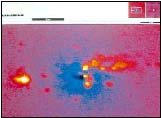By Julie Walker
In one of the sky’s brightest and best-studied galaxies, a research team led by a BYU professor has found the first evidence of a space “geyser”–a phenomenon that periodically throws plumes of hydrogen gas millions of miles into space, creating a rich environment for the birth of new stars.
J. Ward Moody, a BYU assistant professor of physics and astronomy, says the researchers believe galaxy M101 is the site of a space geyser that erupts on an 11-million-year cycle, and that the geyser is caused by an intermediate-sized black hole.
In addition to identifying a new phenomenon, the report in The Astronomical Journal documents a new mid-range category of black holes in a universe inventory that previously included only the super-massive and the minute.
“Your average, vanilla, generic galaxy,” is how M101 has been regarded, says Moody. But when he and his students photographed M101 with a relatively new solid state photographic technique, they found the galaxy is far from ordinary. The image, which was filtered to eliminate star light and to focus on gases, revealed a bizarre string of three knots of gas and stars suspended in an S shape around the galaxy nucleus. The S shape is considered a classic sign of outflow from a central point.

The computer screen of BYU assistant professor J. Ward Moody shows knots of gas surrounding the nucleus of galaxy M101, the home to a newly discovered intermediate-sized black hole.
“You can see three knots of gas, three condensations of gas in a perfect line. That was our first clue that we had something unusual,” says Moody.
“These little points on the outflow path are where stars are being born; they’re little nurseries. A galaxy nucleus is supposed to be an old folks’ home, but these new stars can only exist if there is new gas, young gas, flowing from a recent eruption,” he says.
Moody and his team hypothesize that the knots are emissions from the enter of the galaxy, a moderate-energy black hole that acts as a geyser. Velocity studies show the three knots could have been released at 11 million-year intervals, on alternating sides of the galaxy nucleus. The age of the stars in the clusters indicates that those farthest from the nucleus show the most advanced age, further evidence for a theory that they were released at intervals.
“We use the term ‘geyser’ to differentiate this phenomenon, which is low velocity and probably periodic, from ‘jets,’ which are continuous, have higher velocities, and are associated with much higher-mass, higher energy black holes,” says Moody.
“My guess is that these geysers may be common. Many galaxies, especially spirals like these, show in their nuclei evidence of a recent episode of sudden star formation, and we’ve never known why. If these geysers are common, then they’re a natural explanation for starbursting,” he says.
Contributing authors on the academic paper include Peter Roming, Michael Joner, and Eric Hintz of BYU; Richard Jee of Weber State University in Ogden, Utah; Doug Geisler of the Cerro Tololo Inter-American Observatory; Patrick Durrell of McMaster University in Ontario, Canada; and Paul Scowen of Arizona State University.
While, because of its low energy level and mass, M101’s nucleus was never thought to contain a black hole, the observation of outflow is consistent with theories about black holes. A black hole, a star or galaxy nucleus that has collapsed under its own mass and gravity, acts like a vacuum, pulling in matter and energy from the universe around it. In addition to pulling objects in, black holes are also thought to eject gases and matter. In this lower-intensity black hole, that outflow is propelled by the geyser.
“Compared to M87’s black hole, believed to be more than a billion times the mass of our sun, M101’s black hole is a wimpy garden hose compared to a fire hose,” says Moody. He estimates that the mass of M101’s black hole is probably a million times the mass of our sun, making it one of the smallest ever found outside our galaxy.
“This is the best evidence we’ve ever had for a medium-sized black hole- it’s a missing link that can help us fill in the gaps and find a range between the monsters and the wimps,” he says.
Moody says this lower-energy environment could be very useful to scientists who study black hole behavior. In a super-massive black hole, any outflow is thrown far beyond the nucleus. But because a geyser isn’t powerful enough to propel matter beyond the gravitational and orbital forces of the galaxy nucleus, it holds millions of years of history in perpetual orbit. By studying the ages and properties of the matter in the outflow path, scientists can learn about black holes’ properties and their role in star formation.
While the observation presents a number of new research directions, Moody says his immediate goal is to gather additional information about M101’s geyser, hopefully using data from the Hubble Space Telescope. He also hopes to use the filtration and photography techniques to find other black holes and geysers.
“This is exciting because I think we’ve pioneered a way of looking for some fundamental objects. Now we can use this new method to look for other black holes,” he says.









